Page 439 of 522
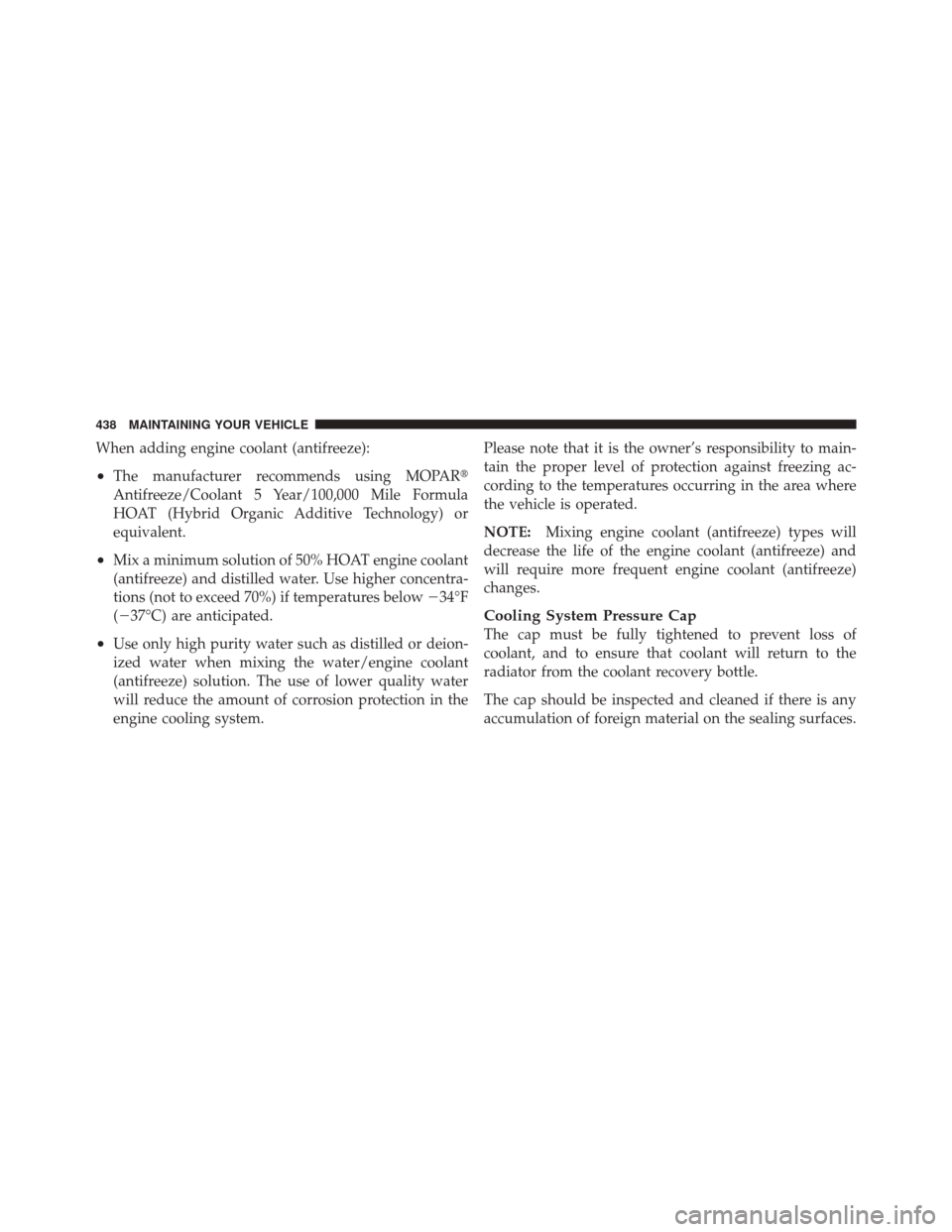
When adding engine coolant (antifreeze):
•The manufacturer recommends using MOPAR�
Antifreeze/Coolant 5 Year/100,000 Mile Formula
HOAT (Hybrid Organic Additive Technology) or
equivalent.
•Mix a minimum solution of 50% HOAT engine coolant
(antifreeze) and distilled water. Use higher concentra-
tions (not to exceed 70%) if temperatures below �34°F
(�37°C) are anticipated.
•Use only high purity water such as distilled or deion-
ized water when mixing the water/engine coolant
(antifreeze) solution. The use of lower quality water
will reduce the amount of corrosion protection in the
engine cooling system. Please note that it is the owner’s responsibility to main-
tain the proper level of protection against freezing ac-
cording to the temperatures occurring in the area where
the vehicle is operated.
NOTE:
Mixing engine coolant (antifreeze) types will
decrease the life of the engine coolant (antifreeze) and
will require more frequent engine coolant (antifreeze)
changes.
Cooling System Pressure Cap
The cap must be fully tightened to prevent loss of
coolant, and to ensure that coolant will return to the
radiator from the coolant recovery bottle.
The cap should be inspected and cleaned if there is any
accumulation of foreign material on the sealing surfaces.
438 MAINTAINING YOUR VEHICLE
Page 451 of 522
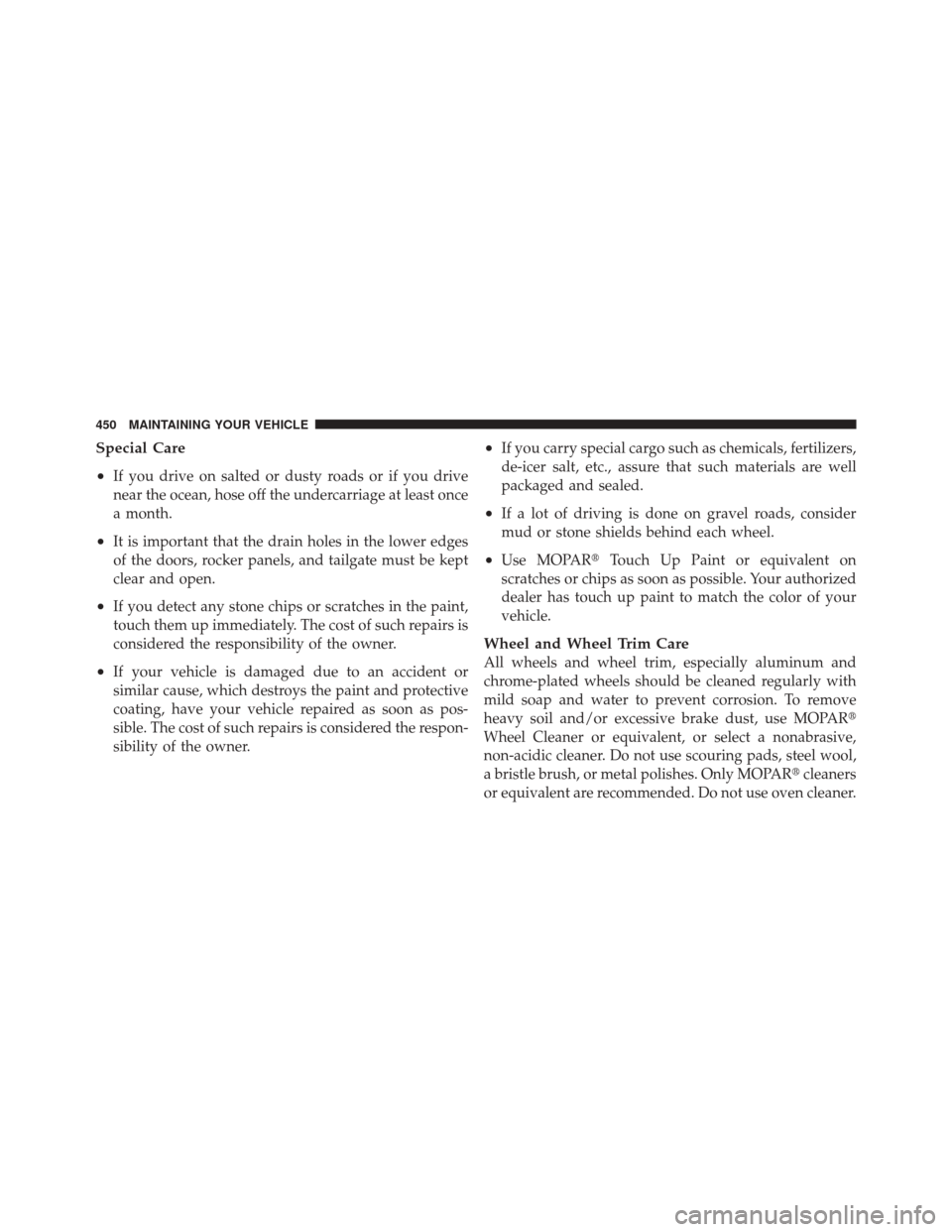
Special Care
•
If you drive on salted or dusty roads or if you drive
near the ocean, hose off the undercarriage at least once
a month.
•It is important that the drain holes in the lower edges
of the doors, rocker panels, and tailgate must be kept
clear and open.
•If you detect any stone chips or scratches in the paint,
touch them up immediately. The cost of such repairs is
considered the responsibility of the owner.
•If your vehicle is damaged due to an accident or
similar cause, which destroys the paint and protective
coating, have your vehicle repaired as soon as pos-
sible. The cost of such repairs is considered the respon-
sibility of the owner.
•If you carry special cargo such as chemicals, fertilizers,
de-icer salt, etc., assure that such materials are well
packaged and sealed.
•If a lot of driving is done on gravel roads, consider
mud or stone shields behind each wheel.
•Use MOPAR�Touch Up Paint or equivalent on
scratches or chips as soon as possible. Your authorized
dealer has touch up paint to match the color of your
vehicle.
Wheel and Wheel Trim Care
All wheels and wheel trim, especially aluminum and
chrome-plated wheels should be cleaned regularly with
mild soap and water to prevent corrosion. To remove
heavy soil and/or excessive brake dust, use MOPAR �
Wheel Cleaner or equivalent, or select a nonabrasive,
non-acidic cleaner. Do not use scouring pads, steel wool,
a bristle brush, or metal polishes. Only MOPAR� cleaners
or equivalent are recommended. Do not use oven cleaner.
450 MAINTAINING YOUR VEHICLE
Page 453 of 522
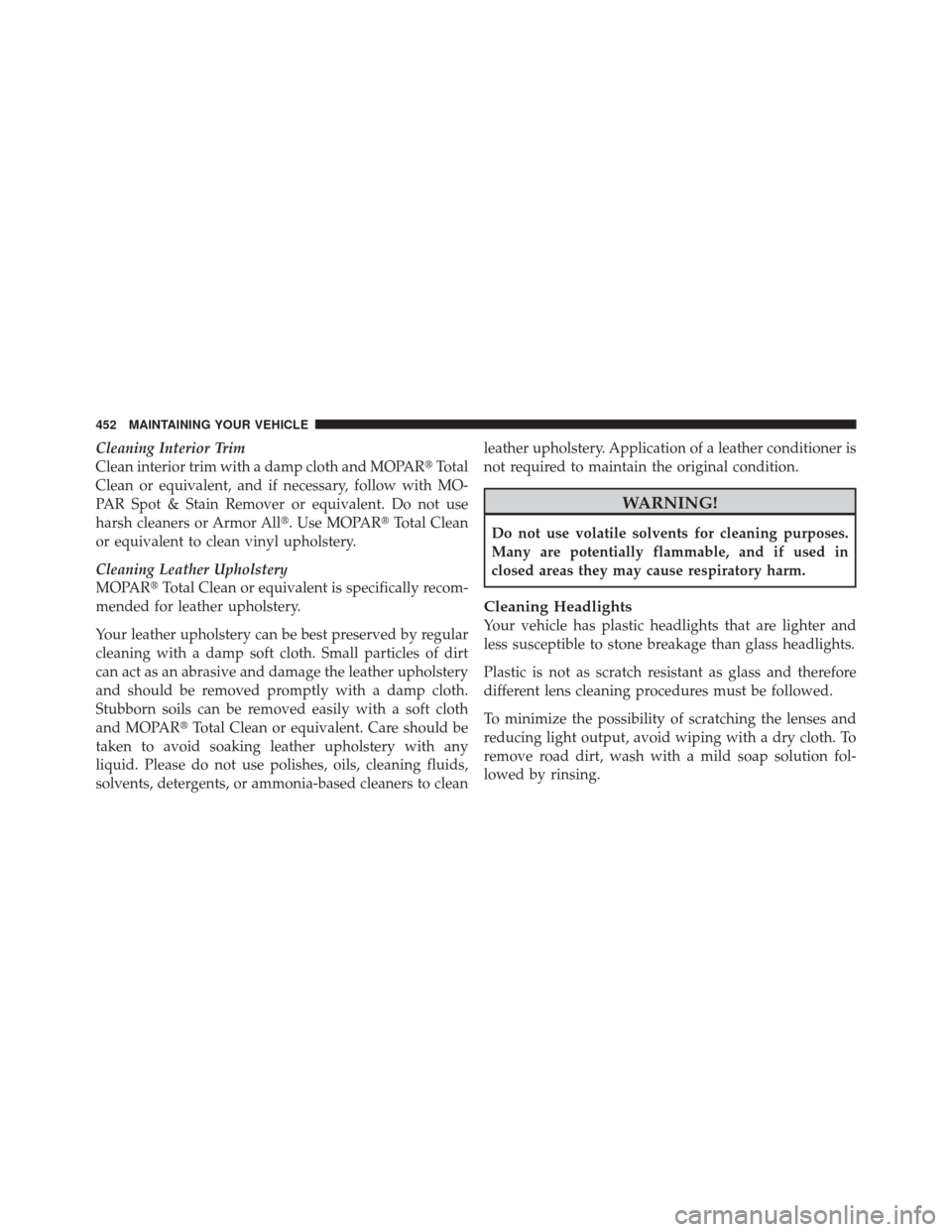
Cleaning Interior Trim
Clean interior trim with a damp cloth and MOPAR�Total
Clean or equivalent, and if necessary, follow with MO-
PAR Spot & Stain Remover or equivalent. Do not use
harsh cleaners or Armor All�. Use MOPAR� Total Clean
or equivalent to clean vinyl upholstery.
Cleaning Leather Upholstery
MOPAR� Total Clean or equivalent is specifically recom-
mended for leather upholstery.
Your leather upholstery can be best preserved by regular
cleaning with a damp soft cloth. Small particles of dirt
can act as an abrasive and damage the leather upholstery
and should be removed promptly with a damp cloth.
Stubborn soils can be removed easily with a soft cloth
and MOPAR� Total Clean or equivalent. Care should be
taken to avoid soaking leather upholstery with any
liquid. Please do not use polishes, oils, cleaning fluids,
solvents, detergents, or ammonia-based cleaners to clean leather upholstery. Application of a leather conditioner is
not required to maintain the original condition.
WARNING!
Do not use volatile solvents for cleaning purposes.
Many are potentially flammable, and if used in
closed areas they may cause respiratory harm.
Cleaning Headlights
Your vehicle has plastic headlights that are lighter and
less susceptible to stone breakage than glass headlights.
Plastic is not as scratch resistant as glass and therefore
different lens cleaning procedures must be followed.
To minimize the possibility of scratching the lenses and
reducing light output, avoid wiping with a dry cloth. To
remove road dirt, wash with a mild soap solution fol-
lowed by rinsing.
452 MAINTAINING YOUR VEHICLE
Page 456 of 522
Cavity CartridgeFuseMini-
Fuse Description
J3 30 Amp Pink — Rear Door Modules
J4 25 Amp White — Driver Door Node
J5 25 Amp White — Passenger Door Node
J6 40 Amp Green — Anti-Lock Brake Sys-
tem (ABS) Pump/ESP
- if equipped
J7 30 Amp Pink — Anti-Lock Brake Sys-
tem (ABS) Valve/ESP
- if equipped
J8 40 Amp Green — Power Seats - if
equipped
J9 40 Amp Green — PZEV/Flex Fuel - if
equippedCavity CartridgeFuseMini-
Fuse Description
J10 30 Amp Pink — Headlamp Wash Re-
lay - if equipped/
Man Tuning Valve - if
equipped
J11 30 Amp Pink — Sway Bar - if
equipped/Thatchm
Lk-Ulk - if equiped/
Pwr Sld Dr Mod - if
equipped
J13 60 Amp Yellow — Ignition Off Draw
(IOD)
J14 40 Amp Green — EBL (Rear Window
Defogger) - if
equipped
J15 30 Amp Pink — Rear Blower - if
equipped
7
MAINTAINING YOUR VEHICLE 455
Page 461 of 522
Cavity CartridgeFuseMini-
Fuse Description
M31 — 20 Amp YellowBack-Up Lights
M32 — 10 Amp RedOccupant Restraint
Controller (ORC)
M33 — 10 Amp RedPowertrain Control
Module (PCM)
M34 — 10 Amp RedPark Assist Module -
if equipped/Heating,
Ventilation, and Air
Conditioning (HVAC)
Module - if
equipped/Compass
Module - if equipped
M35 — 10 Amp RedHeated Mirrors - if
equipped
M36 — 20 Amp YellowPower Outlet #3
(BATT)Cavity Cartridge
FuseMini-
Fuse Description
M37 — 10 Amp RedAnti-Lock Brake Sys-
tem (ABS)/Electronic
Stability Program
(ESP) Module/Stop
Light Switch
M38 — 25 Amp NaturalDoor and Liftgate
Lock/Unlock Motors
CAUTION!
•When installing the Integrated Power Module
cover, it is important to ensure the cover is prop-
erly positioned and fully latched. Failure to do so
may allow water to get into the Integrated Power
Module, and possibly result in an electrical system
failure.
(Continued)
460 MAINTAINING YOUR VEHICLE
Page 494 of 522
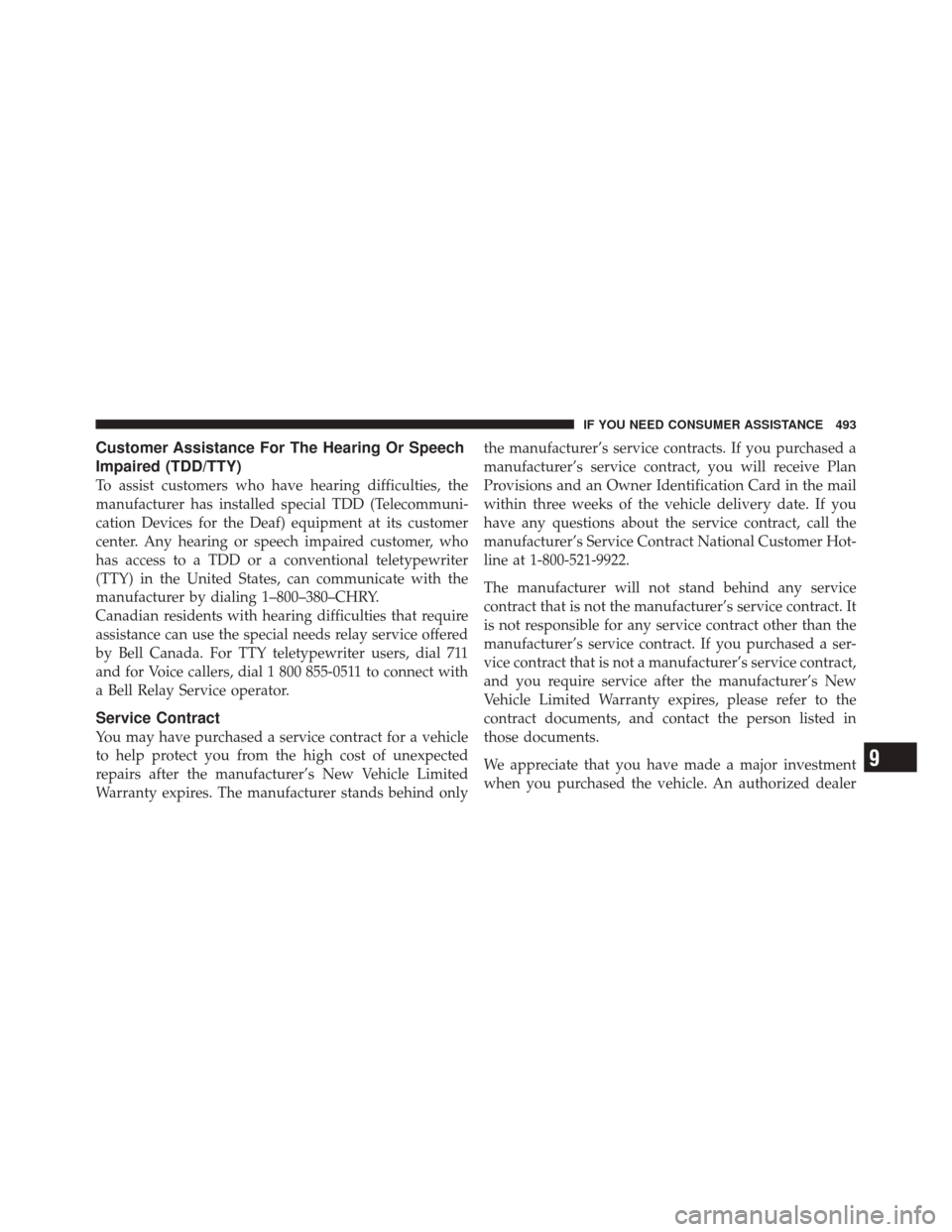
Customer Assistance For The Hearing Or Speech
Impaired (TDD/TTY)
To assist customers who have hearing difficulties, the
manufacturer has installed special TDD (Telecommuni-
cation Devices for the Deaf) equipment at its customer
center. Any hearing or speech impaired customer, who
has access to a TDD or a conventional teletypewriter
(TTY) in the United States, can communicate with the
manufacturer by dialing 1–800–380–CHRY.
Canadian residents with hearing difficulties that require
assistance can use the special needs relay service offered
by Bell Canada. For TTY teletypewriter users, dial 711
and for Voice callers, dial 1 800 855-0511 to connect with
a Bell Relay Service operator.
Service Contract
You may have purchased a service contract for a vehicle
to help protect you from the high cost of unexpected
repairs after the manufacturer’s New Vehicle Limited
Warranty expires. The manufacturer stands behind onlythe manufacturer’s service contracts. If you purchased a
manufacturer’s service contract, you will receive Plan
Provisions and an Owner Identification Card in the mail
within three weeks of the vehicle delivery date. If you
have any questions about the service contract, call the
manufacturer’s Service Contract National Customer Hot-
line at 1-800-521-9922.
The manufacturer will not stand behind any service
contract that is not the manufacturer’s service contract. It
is not responsible for any service contract other than the
manufacturer’s service contract. If you purchased a ser-
vice contract that is not a manufacturer’s service contract,
and you require service after the manufacturer’s New
Vehicle Limited Warranty expires, please refer to the
contract documents, and contact the person listed in
those documents.
We appreciate that you have made a major investment
when you purchased the vehicle. An authorized dealer
9
IF YOU NEED CONSUMER ASSISTANCE 493
Page 499 of 522
Temperature Grades
The temperature grades are A (the highest), B, and C,
representing the tire’s resistance to the generation of heat
and its ability to dissipate heat, when tested under
controlled conditions on a specified indoor laboratory
test wheel. Sustained high temperature can cause the
material of the tire to degenerate and reduce tire life, and
excessive temperature can lead to sudden tire failure. The
grade C corresponds to a level of performance, which all
passenger car tires must meet under the Federal Motor
Vehicle Safety Standard No. 109. Grades B and A repre-
sent higher levels of performance on the laboratory test
wheel, than the minimum required by law.WARNING!
The temperature grade for this tire is established for
a tire that is properly inflated and not overloaded.
Excessive speed, under-inflation, or excessive load-
ing, either separately or in combination, can cause
heat buildup and possible tire failure.
498 IF YOU NEED CONSUMER ASSISTANCE
Page 505 of 522
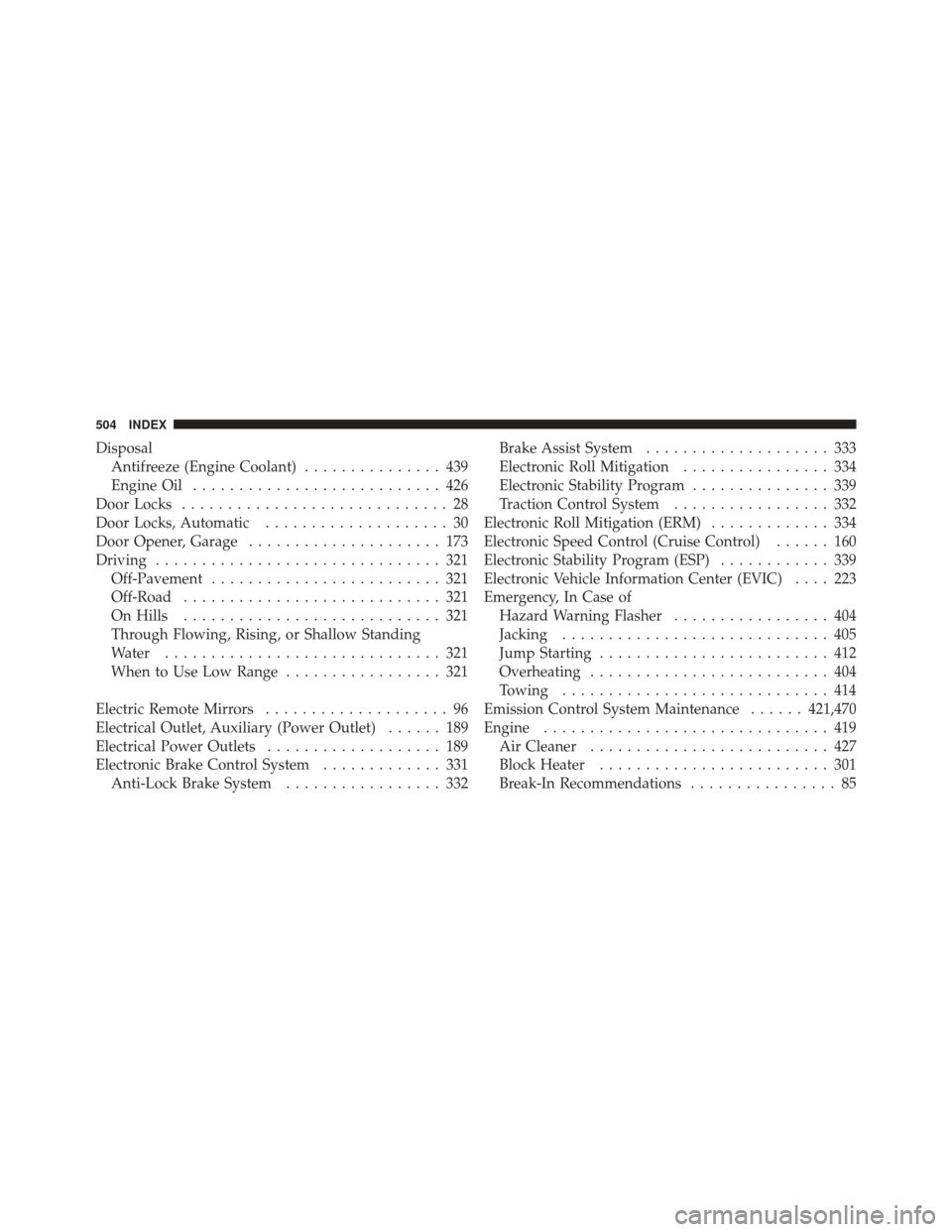
DisposalAntifreeze (Engine Coolant) ............... 439
Engine Oil ........................... 426
Door Locks ............................. 28
Door Locks, Automatic .................... 30
Door Opener, Garage ..................... 173
Driving ............................... 321
Off-Pavement ......................... 321
Off-Road ............................ 321
On Hills ............................ 321
Through Flowing, Rising, or Shallow Standing
Water .............................. 321
When to Use Low Range ................. 321
Electric Remote Mirrors .................... 96
Electrical Outlet, Auxiliary (Power Outlet) ...... 189
Electrical Power Outlets ................... 189
Electronic Brake Control System ............. 331
Anti-Lock Brake System ................. 332 Brake Assist System
.................... 333
Electronic Roll Mitigation ................ 334
Electronic Stability Program ............... 339
Traction Control System ................. 332
Electronic Roll Mitigation (ERM) ............. 334
Electronic Speed Control (Cruise Control) ...... 160
Electronic Stability Program (ESP) ............ 339
Electronic Vehicle Information Center (EVIC) .... 223
Emergency, In Case of Hazard Warning Flasher ................. 404
Jacking ............................. 405
Jump Starting ......................... 412
Overheating .......................... 404
Towing ............................. 414
Emission Control System Maintenance ......421,470
Engine ............................... 419
Air Cleaner .......................... 427
Block Heater ......................... 301
Break-In Recommendations ................ 85
504 INDEX